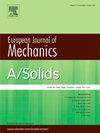Controllably ultrawide bandgap of a metamaterial beam based on inertial amplification and magnetorheological elastomer
IF 4.4
2区 工程技术
Q1 MECHANICS
引用次数: 0
Abstract
This paper presents the design of a metamaterial beam for controllably ultrawide bandgap (36.3Hz–218.6Hz) and low-frequency vibration attenuation, achieved by a lever-based inertial amplification and a variable stiffness of a magnetorheological elastomer (MRE) modulated by an external magnetic field. The metamaterial is formed by periodical mass-lever inertial amplifier and spring-MRE resonators connected to a base beam. The Galerkin method is employed to theoretically investigate the controllably ultrawide tunability of a low-frequency bandgap in terms of the MRE properties, the mass-lever inertial amplification and the geometric nonlinearity conditions. The results obtained are validated through numerical simulations. The study further extends to lightweight design of metamaterials, where the target frequency that depends on controllably ultrawide bandgap is introduced. With the same target frequency of bandgap, the proposed system exhibits a lighter resonator mass than the traditional metamaterials. Finally, a target frequency-based bandgap control strategy is developed, enabling real-time tunability of the bandgap within a low-frequency wideband range without changing the mass of the resonator or reconstructing the structure. Compared to typical "mass-spring" metamaterials, the proposed system shows superiority in achieving ultrawide bandgaps. This metamaterial offers a promising solution for creating controllably ultrawide vibration-attenuating structures, making it highly suitable for practical applications.
基于惯性放大和磁流变弹性体的可控超宽带隙超材料光束
本文介绍了一种超材料横梁的设计,通过基于杠杆的惯性放大和磁流变弹性体(MRE)在外部磁场调制下的可变刚度,实现可控的超宽带隙(36.3Hz-218.6Hz)和低频振动衰减。超材料由周期性质量杠杆惯性放大器和弹簧-磁流变弹性体谐振器组成,并与基梁相连。本文采用伽勒金方法,从 MRE 特性、质量杠杆惯性放大和几何非线性条件等方面,对低频带隙的可控超宽可调性进行了理论研究。数值模拟验证了所获得的结果。研究进一步扩展到超材料的轻量化设计,引入了取决于可控超宽带隙的目标频率。在带隙目标频率相同的情况下,与传统超材料相比,所提出的系统具有更轻的谐振器质量。最后,还开发了一种基于目标频率的带隙控制策略,可在低频宽带范围内实现带隙的实时可调,而无需改变谐振器的质量或重建结构。与典型的 "质量弹簧 "超材料相比,所提出的系统在实现超宽带隙方面表现出了优越性。这种超材料为创建可控的超宽振动衰减结构提供了一种有前途的解决方案,因此非常适合实际应用。
本文章由计算机程序翻译,如有差异,请以英文原文为准。
求助全文
约1分钟内获得全文
求助全文
来源期刊
CiteScore
7.00
自引率
7.30%
发文量
275
审稿时长
48 days
期刊介绍:
The European Journal of Mechanics endash; A/Solids continues to publish articles in English in all areas of Solid Mechanics from the physical and mathematical basis to materials engineering, technological applications and methods of modern computational mechanics, both pure and applied research.

 求助内容:
求助内容: 应助结果提醒方式:
应助结果提醒方式:


